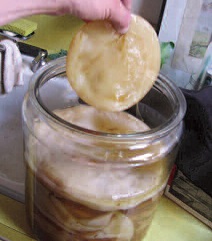GARDEN WORKS: Kombucha: Hooch or healer?
 by Emily Cates
by Emily Cates
Conclusion: The Making of a “Miracle” Drink
Last time we took a look at the popular, yet controversial health tonic known as kombucha, and a few reasons why people drink it. This time, let’s explore a method behind the making of kombucha, highlighting needed containers, ingredients, and how to ensure a successful batch.
So, exactly how is kombucha made? And what’s that “mother” thingy all about? It’s the same idea as turning fruit juice into vinegar, the same organisms involved. (Ever heard of raw apple cider vinegar with “the mother”?) Instead of fruit juice or cider, however, the sugar source in kombucha is whatever is mixed in with the tea, such as plain sugar. The mother is a rubbery, pancake-shaped symbiotic colony of bacteria and yeast (SCOBY), that work together as they feed off the sugars and convert them into acids. You can oftentimes see a mother or pieces of one in a bottle of raw apple cider vinegar or store-bought unpasteurized kombucha. (I’ve used these to start a fresh batch with good results.) As each batch matures – in about two weeks – a new mother layer grows on top of the previous layer. These layers may now be separated to start new batches, or they will eventually pile up and take up all the space in the brewing vessel.

The “mother” in a batch of kombucha.
Speaking of the brewing vessel, be sure it’s non-metallic and not porcelain. Metals and lead can leach out into kombucha. A scrupulously clean, wide-mouthed glass jug with a non-metallic, loosely-fitted cover is a good idea. Start small at first, perhaps with a quart jar, to minimize the risks of losing a large batch if things don’t turn out as hoped for. Also, use organic ingredients such as black, green, oolong, chai, or other teas, organic sugars, and filtered water. Be aware, also, that there may be the possibility of a batch with an alcohol content of 5 percent. In theory there should be a minimal amount of alcohol, since the ingredients and mother are supposed to convert towards the vinegar side – though I have seen for myself that it doesn’t always happen that way in home brews. Keep your eyes out for mold, too, discarding the whole batch, and- if desired – starting fresh with a sterile vessel and a brand new mother. Alternately, if a mother is not available, a half cup or so of a previous batch, or store-bought raw kombucha may be added to the cooled mix before pouring into the vessel.
And, speaking of discarding a batch, be sure to get rid of any surplus mothers or raw kombucha appropriately. Never flush or dump down the drain, or you’ll grow a monster mother in your sewer – Ewww! Your compost pile will happily accommodate, as will your chickens or pigs.
So, now that you’ve heard the do’s and don’ts of making kombucha and wish to proceed, boil some water. Add your tea and sugar, then stir and cool to room temperature. Pour into the vessel and carefully place the mother on top. Cover and wait a couple weeks or so. When it is no longer sweet, it’s ready. Feel free to cut it with varying amounts of homemade juice and/or herbs and spices from the garden. The makings of a miracle drink? Maybe you’ll want to brew some up and then decide.
Responsible journalism is hard work!
It is also expensive!
If you enjoy reading The Town Line and the good news we bring you each week, would you consider a donation to help us continue the work we’re doing?
The Town Line is a 501(c)(3) nonprofit private foundation, and all donations are tax deductible under the Internal Revenue Service code.
To help, please visit our online donation page or mail a check payable to The Town Line, PO Box 89, South China, ME 04358. Your contribution is appreciated!


Leave a Reply
Want to join the discussion?Feel free to contribute!